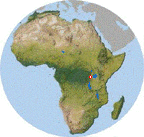 Bwindi-Impenetrable Forest, Uganda
Bwindi-Impenetrable Forest, Uganda Bwindi-Impenetrable Forest, Uganda
Bwindi-Impenetrable Forest, UgandaThere are several localities within the Park at which apes are being studied. At lower elevations (1450m), Buhoma has two habituated gorilla groups which are visited daily by tourists; tourists do not visit the other low site, Nteko. Chimpanzees are present at both low elevation localities. The higher site (Ruhija, 2,150m) is not visited by tourists and one group is habituated; chimpanzees rarely if ever range at this altitude. The Park has gained popularity as a tourist destination in the last few years. There are 120 species of mammals, 346 species of birds, 202 species of butterflies, and 163 species of trees (Kilimanjaro Adventure Travel). See the BIGAPE website for detailed description of research.
Primary source for the following Site Data --- the Bwindi-Impenetrable Great Ape Project (BIGAPE) website at http://www-rcf.usc.edu/~stanford/bigape.html and Craig Stanford, personal communication; see also http://www-anthro.ucdavis.edu/features/gcn/gsmith.htm
| Name: | Bwindi-Impenetrable National Park |
| Location: | Uganda (soutwestern) 1° 04' S, 29° 38' E (Camp Kashasha, BIGAPE project camp) |
| Status: | National Park |
| Area: | 331 km2 |
| Altitude: | 1,200 - 2,500m (Camp Kashasha is 1,750m, elevation at Ruhiza group's range is about 2100m) |
| Temp: | --- °C |
| Rainfall: | --- |
| Vegetation: | Montane wet evergreen forest |
|
Human influence: |
--- Disturbance ratings -- 2,3,2,[2-4],3 (habituation depends on area and species) |
|
Closest village: | to Nkuringo = Ntungamo village (about 1km); to Ruhiza = Ruhiza village (about 5km) |
|
Species studied: | P. t. schweinfurthii, G. g. beringei |
|
Population density: | gorillas: 300 in 331 sq. km (but absent from northern 1/4 of park), for 0.9 - 1.2 individuals per km2; chimpanzees very rough estimate 350-400 in same area or roughly 1 - 1.2 individuals per km2 |
| Fauna: | --- |
|
Study period: | Nkuringo study area began 1996 |
| Habituation: | minimal |
|
Research presence: | continuous at both sites |
| Conservation: | major conservation effort and ecotourism ongoing |
|
Current research: | sympatric ecology, dietary ecology, habitat use |
| Methods: | focal fruit tree observations of chimpanzees; gorilla tracking for path length and food-from-dung data and also nest data |
|
Contact person: | Craig B. Stanford, Dept. of Anthropology, USC, Los Angeles, CA 90089-0032 |
| Habitat photos: | Some photos of the site, courtesy of Craig Stanford. |
| Maps | --- |
| Aerial photos | --- |
| Bibliography | References relating to Bwindi |
| |
| Miscellaneous | Related links |